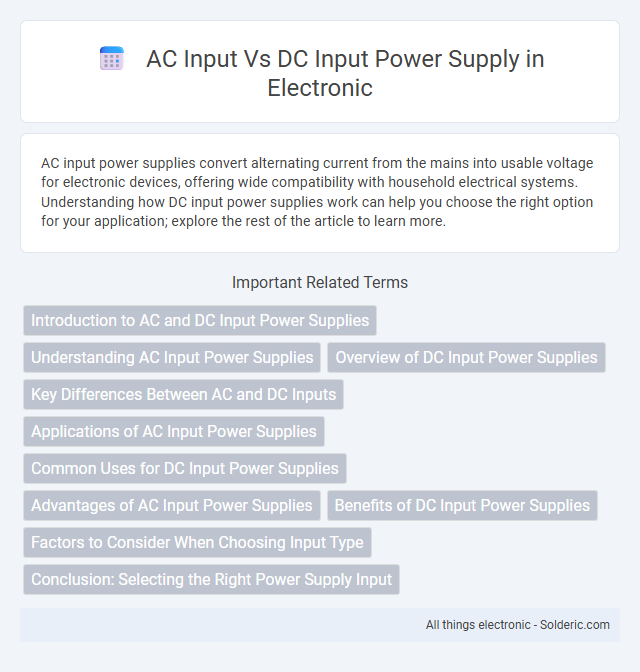AC input power supplies convert alternating current from the mains into usable voltage for electronic devices, offering wide compatibility with household electrical systems. Understanding how DC input power supplies work can help you choose the right option for your application; explore the rest of the article to learn more.
Comparison Table
| Feature | AC Input Power Supply | DC Input Power Supply |
|---|---|---|
| Input Type | Alternating Current (AC) | Direct Current (DC) |
| Voltage Range | Typically 100-240V AC | Varies, commonly 12-48V DC |
| Conversion | Requires rectification to DC | No conversion needed, direct DC output |
| Efficiency | Moderate, impacted by AC-DC conversion losses | Higher, minimal conversion losses |
| Use Cases | General electronics, household devices | Battery-powered systems, solar applications |
| Size & Complexity | Bulkier due to transformers and rectifiers | More compact, simpler design |
| Cost | Often more expensive due to components | Generally cheaper with fewer components |
| Input Noise | Higher electromagnetic interference (EMI) | Lower EMI, cleaner input signal |
| Application Examples | PC power supplies, home appliances | Electric vehicles, solar charge controllers |
Introduction to AC and DC Input Power Supplies
AC input power supplies convert alternating current from the grid into a stable output voltage suitable for electronic devices, while DC input power supplies accept direct current, often sourced from batteries or solar panels, to power equipment. Your choice between AC and DC input depends on the availability and type of power source, with AC input commonly used in residential and commercial applications and DC input preferred in portable or renewable energy systems. Understanding the differences in conversion methods and input characteristics is essential for optimizing power supply efficiency and compatibility.
Understanding AC Input Power Supplies
AC input power supplies convert alternating current from the mains into regulated DC output, ensuring stable voltage for electronic devices. They feature components such as transformers, rectifiers, and filters to manage voltage fluctuations and reduce electrical noise. Understanding these power supplies helps you choose reliable equipment that protects your systems from power surges and inefficiencies.
Overview of DC Input Power Supplies
DC input power supplies convert direct current from sources such as batteries or solar panels into stable, usable voltage for electronic devices, ensuring reliable performance in low-voltage applications. These power supplies often feature high efficiency, reduced electromagnetic interference, and compact designs compared to AC input models, making them ideal for portable and remote systems. Your choice of a DC input power supply directly impacts device longevity and operational consistency, especially in environments lacking consistent AC power.
Key Differences Between AC and DC Inputs
AC input power supplies convert alternating current from the mains into usable DC voltage, characterized by periodic voltage reversals, while DC input power supplies directly accept a constant unidirectional current. AC power inputs require rectification and filtering to stabilize voltage, whereas DC inputs simplify design by eliminating these steps, enhancing efficiency in certain applications. Understanding these key differences helps you select the appropriate power supply for devices requiring consistent and reliable power delivery.
Applications of AC Input Power Supplies
AC input power supplies are widely used in household appliances, industrial machinery, and office equipment due to their compatibility with standard electrical grids. They efficiently convert alternating current from wall outlets into the required DC voltage for sensitive electronics. These power supplies are essential in applications requiring stable and reliable power conversion from AC mains, including consumer electronics, medical devices, and telecommunications systems.
Common Uses for DC Input Power Supplies
DC input power supplies are commonly used in applications requiring consistent, stable voltage sources such as telecommunications, industrial automation, and battery-powered devices. You will find DC input power supplies essential for powering robotics, data centers, and renewable energy systems where direct current is the primary power format. These power supplies ensure efficient energy conversion and reliability for sensitive electronic equipment that depends on steady DC voltage.
Advantages of AC Input Power Supplies
AC input power supplies offer higher efficiency in voltage transformation and long-distance transmission, reducing energy loss and enabling stable power delivery. They provide compatibility with widely available AC mains power, simplifying integration and lowering overall infrastructure costs. Moreover, AC input power supplies typically feature robust surge protection and better performance in fluctuating power conditions.
Benefits of DC Input Power Supplies
DC input power supplies offer higher energy efficiency and reduced power loss compared to AC input options, enhancing operational reliability and lowering electricity costs. These power supplies provide more stable and consistent voltage output, which improves the performance and lifespan of sensitive electronic components. Choosing a DC input power supply can boost your system's overall efficiency by minimizing electromagnetic interference and reducing the need for complex rectification circuitry.
Factors to Consider When Choosing Input Type
When choosing between AC input and DC input power supplies, consider the source voltage availability, efficiency requirements, and application environment. AC input power supplies are suitable for standard grid power and offer simpler voltage conversion, while DC input power supplies are ideal for battery-operated or renewable energy systems requiring stable, low-noise output. Compatibility with existing infrastructure, power quality, and regulatory compliance are critical for optimal performance and reliability.
Conclusion: Selecting the Right Power Supply Input
Choosing the right power supply input depends on your device's operational environment and efficiency requirements. AC input power supplies are ideal for standard electrical outlets and offer wide compatibility, while DC input power supplies ensure stable voltage for battery-powered or renewable energy systems. Understanding your specific voltage source, power stability needs, and application constraints will guide you in selecting the most reliable and efficient power supply input.
AC Input vs DC Input Power Supply Infographic

 solderic.com
solderic.com